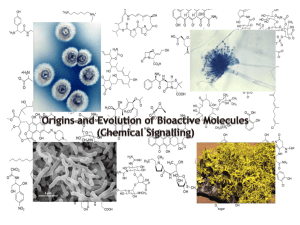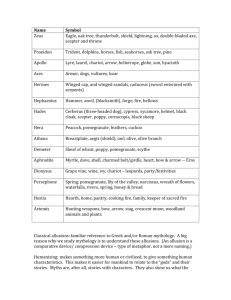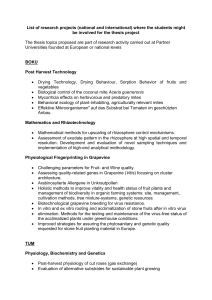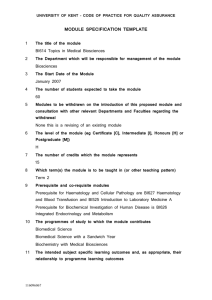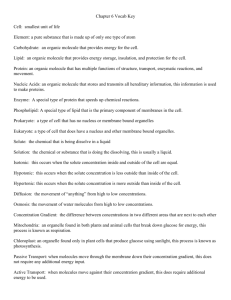Microsoft Word
advertisement
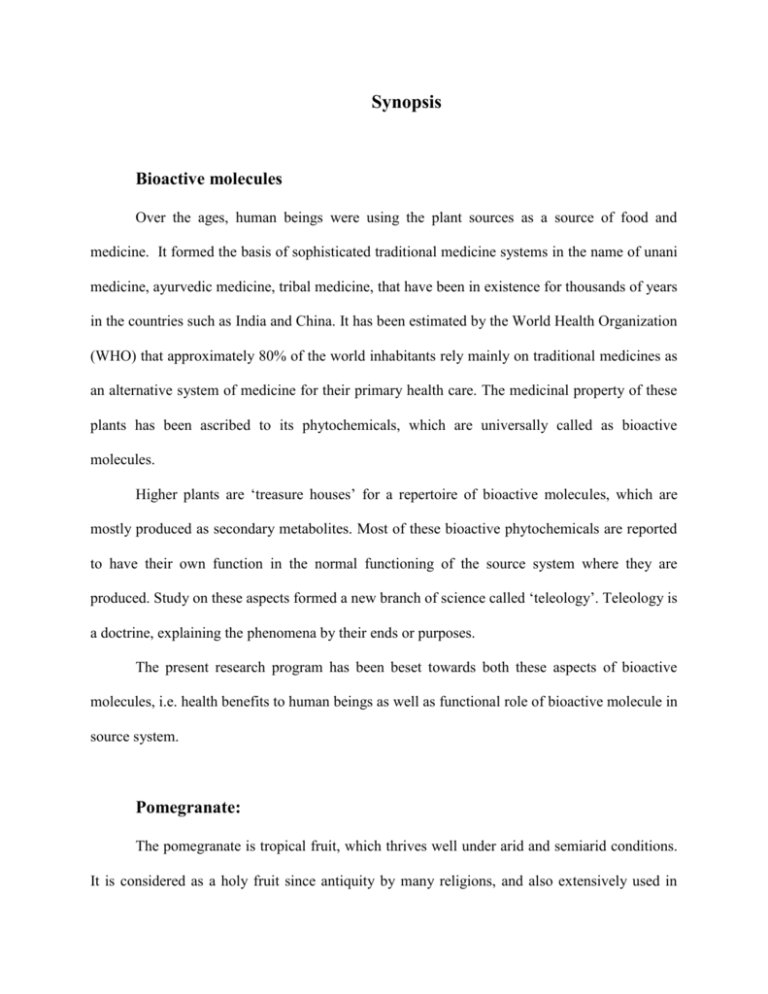
Synopsis Bioactive molecules Over the ages, human beings were using the plant sources as a source of food and medicine. It formed the basis of sophisticated traditional medicine systems in the name of unani medicine, ayurvedic medicine, tribal medicine, that have been in existence for thousands of years in the countries such as India and China. It has been estimated by the World Health Organization (WHO) that approximately 80% of the world inhabitants rely mainly on traditional medicines as an alternative system of medicine for their primary health care. The medicinal property of these plants has been ascribed to its phytochemicals, which are universally called as bioactive molecules. Higher plants are ‘treasure houses’ for a repertoire of bioactive molecules, which are mostly produced as secondary metabolites. Most of these bioactive phytochemicals are reported to have their own function in the normal functioning of the source system where they are produced. Study on these aspects formed a new branch of science called ‘teleology’. Teleology is a doctrine, explaining the phenomena by their ends or purposes. The present research program has been beset towards both these aspects of bioactive molecules, i.e. health benefits to human beings as well as functional role of bioactive molecule in source system. Pomegranate: The pomegranate is tropical fruit, which thrives well under arid and semiarid conditions. It is considered as a holy fruit since antiquity by many religions, and also extensively used in folk medicine of many cultures including Indian, Chinese, Greek, Hebrew and Babylonians. Most of its health beneficial properties were proved in recent findings by several researchers. A voluminous literature has been accumulated on various and health beneficial properties of different parts of the pomegranate fruit and bioactive molecules responsible. The pith and carpellary membrane constitutes 13% of the pomegranate fruit and there is an expressed doubt that phylogenetically carpellary membrane might have evolved to provide a structural and functional protection to the arils. Further it appears to play a definite role in maintaining the quality of the arils. does carpellary membrane evolved to impart functional or regulatory role? It is an intrigue question, which has been attempted to answer. Accordingly, the following work plan was proposed initially and carried out during the present Ph.D. program 1. Isolation and characterization of bioactive molecule from pith and carpellary membrane of pomegranate fruit 2. Study on different functional attributes of bioactive molecule towards human health benefits 3. Elucidation of internal browning disorder of pomegranate fruit and role of bioactive molecules in it. The results obtained were thus consolidated as a Ph.D. thesis. The thesis preceded with ‘General introduction and review of literature’ followed by a brief account on the scope of the present investigation. The general structure of the three chapters that follows consists of a brief introduction, review of literature, materials and methods, results and discussion and summary. The salient feature inferred from the investigation are summarized under the heading of ‘General summary and conclusion’ at the end of the thesis, followed by bibliography. General Introduction and review of literature Introduction addresses relevant literature on bioactive molecules towards human health benefits and a detailed information about pomegranate fruit. The aspects covered regarding pomegranate includes its origin, history of cultivation, taxonomy, vernacular names, varieties, fruit structure, functional attributes of different parts of pomegranate fruit towards human health, including juice, peel and seeds. The literature survey regarding the pomegranate fruit exposed the lacunae on any information concerned to pith and carpellary membrane on functional role as phyto-protective or as health beneficial factors. Finally scope of the present investigations is indicated. Chapter I Isolation and characterization of bioactive molecule from pith and carpellary membrane of pomegranate fruit This chapter enumerates the techniques employed for isolation and characterization of the bioactive molecules from the pomegranate fruit pith and carpellary membrane. The initial screening of pith and CM for possible bioactivity by extraction with different solvents and subsequent bioactivity assay demonstrated that methanol extract could be a potential source of bioactive molecule. Methanol extraction of pith and carpellary membrane followed by repeated column chromatography and preparative HPLC proved successful in isolating a bioactive molecule from it. The spectroscopic analysis viz. UV-visible, infrared spectroscopy, nuclear magnetic resonance spectroscopy and mass spectroscopy (GC-MS and MALDI-MS) data reeled the structure of the bioactive molecule as a punicalagin. Which is a high molecular weight polyphenol. The acid hydrolysis followed by HPLC and LC-MS analysis revealed the presence of gallic acid, ellagic acid, gallagic acid, punicalin and punicalagin. Among these molecules punicalin was found in higher concentration in the pith and carpellary membrane of pomegranate fruit. The antioxidant activity revealed that punicalagin is most potent one among the five molecules mentioned above. The punicalagin was reported for the first time from pomegranate fruit pith and carpellary membrane from our work Chapter II Functional properties of Punicalagin isolated from pith and carpellary membrane of pomegranate fruit This chapter encompasses a brief introduction followed by various functional attributes of punicalagin studied in the present work like antioxidant activity, binding with human serum albumin (HSA), DNA, antiplatelet aggregation, low cytotoxicity, and antibacterial activity. The antioxidant potential of punicalagin was assessed by radical scavenging assays using DPPH, superoxide, and ABTS radicals. The antioxidant activity was also assessed in terms of lipid peroxidation inhibitory activity in liver microsomal system, total reducing power. The kinetics of free radical reactions of punicalagin with various free radicals generated in-vitro using pulse radiolytically was also studied. The reduction potential of punicalagin was also determined by cyclic voltametric and differential voltametric techniques, which measures the electron donating ability of a antioxidant a various pH range. Results indicated that its higher electron donating potential at neutral pH. In addition, the antioxidant potential of the punicalagin was also assessed in terms of its metal ion (Iron and copper) chelating activity. The results proved the potential antioxidant activity of punicalagin in all the methods of assay. In order to study the bioavailability of punicalagin across the body, a study on interaction of punicalagin with HSA protein was carried out. Since the later is known to act as transport protein for many drug molecules. The results revealed the potential HSA binding ability of punicalagin, which also suggests the possible bioavailability of punicalagin. Punicalagin and DNA interaction study was carried out to find out any possible interaction, which can render it to an anticancer drug by binding with later. The study showed that, punicalagin binds with DNA with low affinity with possible hydrogen bonding. Further punicalagin showed moderate platelet aggregation inhibitory activity against the adenosine diphosphate and collagen agonists in an in-vitro study. The low cytotoxicity of punicalagin proved in our study on three cell lines viz. Vero (Normal African green monkey kidney cell line), Hep-2 (Human larynx epithelial cancer cell line) and A-549 (Human small cell lung carcinoma cell line) maintained in laboratory conditions added to its functional activity. The higher functional attributes and low cytotoxicity associated with bioavailability rendered the punicalagin in to promising multifunctional molecule. The possible antibacterial activity of punicalagin was tested against clinically important gram-negative bacteria viz. viz. Enterobacter aerogenes, Escherichia coli, Proteus mirabilis, Pseudomonas aeruginosa, salmonella typhi and Shigella dysenteriae. Results revealed its broadspectrum antibacterial activity of punicalagin against the above food borne pathogens. The acetone extract and methanol extract of pith and CM also showed potential antibacterial activity. Chapter III Elucidation of mechanism of internal browning in pomegranate fruit and role of bioactive molecules in internal browning Internal browning of pomegranate arils forms the major bottleneck for commercial exploitation for processing and for export trades. For the first time a detailed investigation was undertaken in the present program of work to have a mechanistic insight in to the mechanism of internal browning of arils and also role of bioactive molecules (punicalagin and its derivatives) in it, which was discussed in the present chapter. The biochemical analysis of arils under different stages of fruit development and browning indicated that incidence of internal browning is associated with ripening/senescence changes and involved with an array of inter linked endogenous biochemical factors like pH, organic acid content, water content, anthocyanin content, phenolic content, calcium, peroxidase (POD) and polyphenol oxidase (PPO) activities. From the results it appears that ripening/senescence changes associated with membrane disintegration, which leads to decreased water content, organic acid content, and increased calcium content resulting in the increase in pH of the arils. On the other hand, disintegration of cellular compartmentation due to the loss of membrane integrity exposes the enzymes to their substrates, in particular polyphenol oxidase and peroxidase enzymes. The increase in pH of the arils has been identified as one of the critical factor, which induces the reversible structural transformation of anthocyanin pigments resulting in discoloration of arils. In addition increase in pH also provides optimum pH conditions for the higher activity of PPO and POD enzymes, which leads to the browning in pomegranate arils. A gradual decrease in the concentration of punicalagin and its derivatives in the arils observed during fruit development, maturation, ripening and senescence coinciding with increase in anthocyanin content suggests their possible role in the synthesis of anthocyanin pigments. Similarly increase in browning of arils recorded a drastic decrease in the concentration of punicalagin and its derivatives except gallic acid. It appears that there is a delicate balance between internal browning of pomegranate arils with bioactive molecules along with biochemical attributes of arils. The chapter encompasses the detailed discussion on these aspects. General summary and conclusion In this section of the thesis, salient features inferred from this investigation are summarized as follows: For the first time, pith and carpellary of the pomegranate fruit waste was explored as a source of the potential bioactive molecules For the first time punicalagin, the high molecular weight polyphenolic bioactive molecule was isolated from pith and carpellary membrane The punicalagin showed potential antioxidant activity in terms of radical scavenging activity, lipid peroxidation inhibition, metal chelating activity and electron donating ability Pulse radiolysis studies reveled the kinetics of radical scavenging ability and also its ability to repair tryptophan radicals generated in-vitro The DNA binding and platelet aggregation inhibition, and antibacterial activity of the punicalagin adds to its fame as a functional properties Low cytotoxicity and its interaction with HSA rendered it as promising multifunctional and biologically available bioactive molecule Based on the extensive research data generated through biochemical analysis of arils during fruit development and during browning of arils, for the first time mechanism of internal browning in pomegranate fruit was elucidated and also role of bioactive molecules in it
